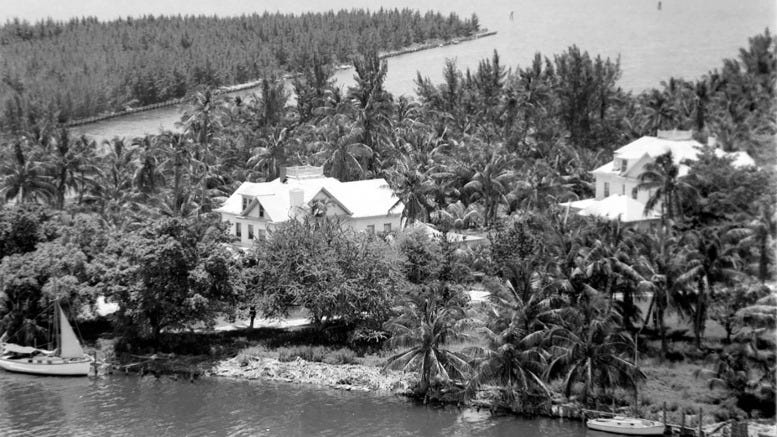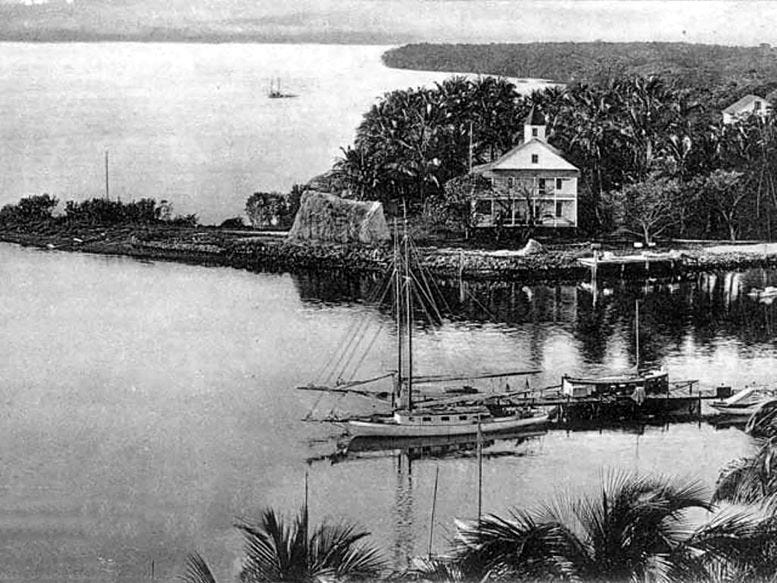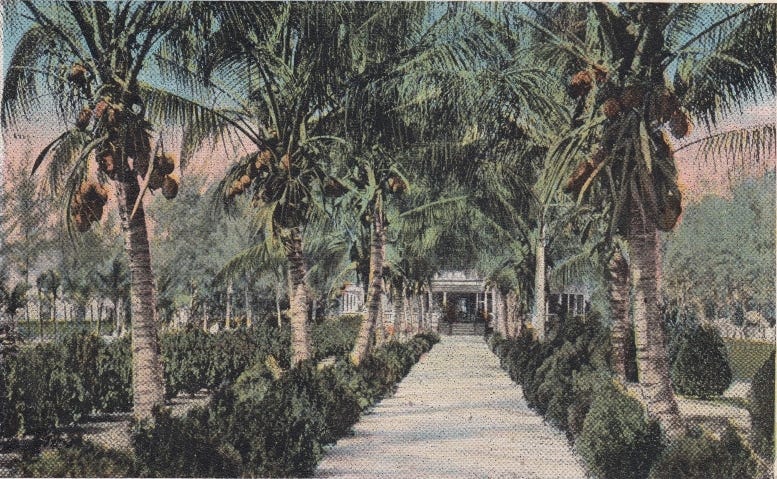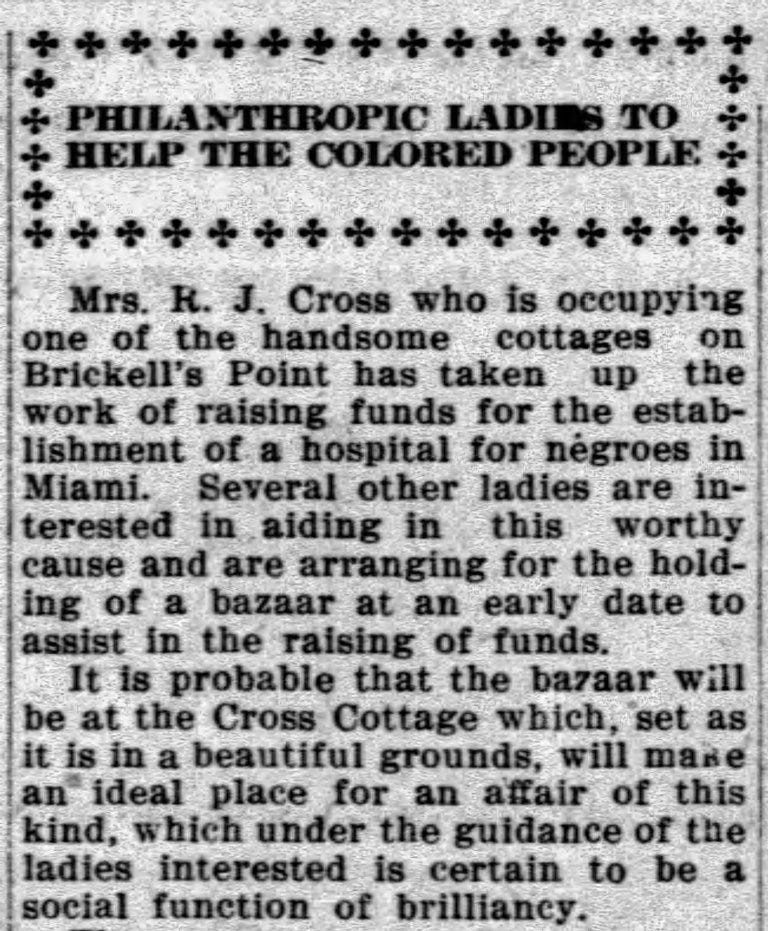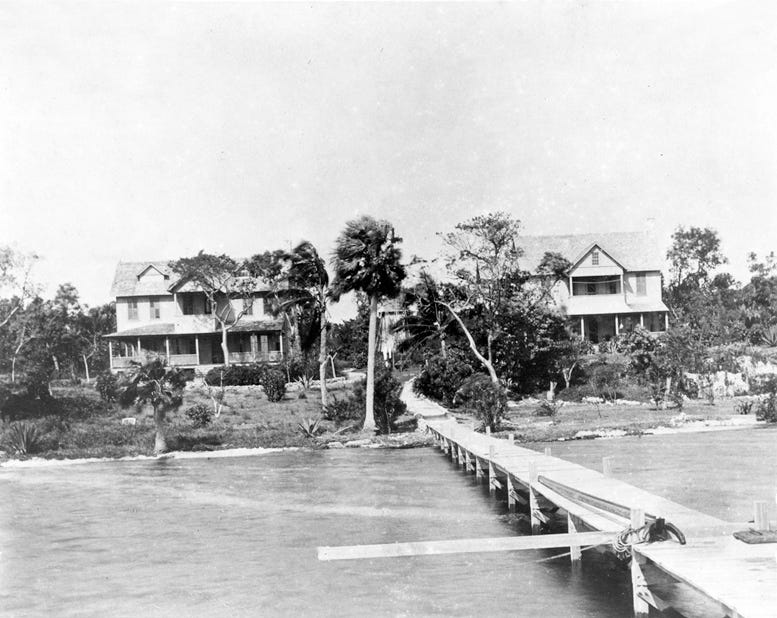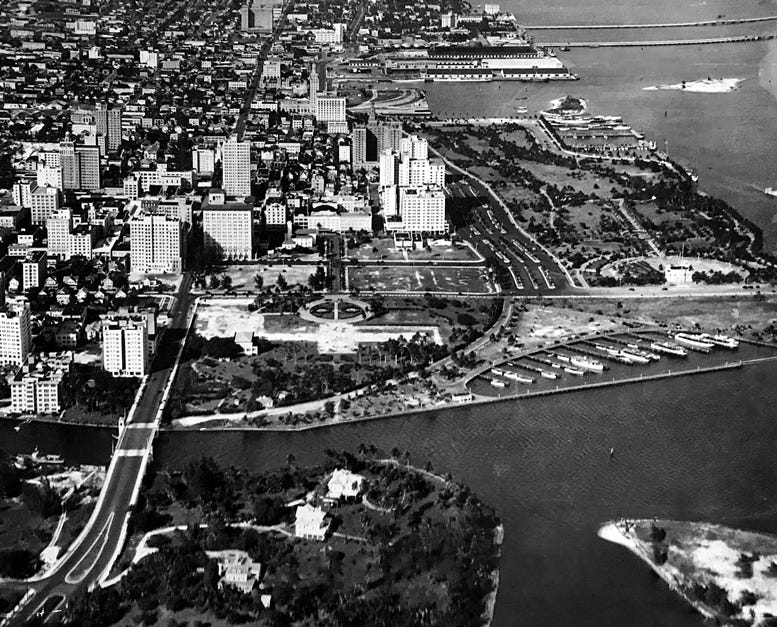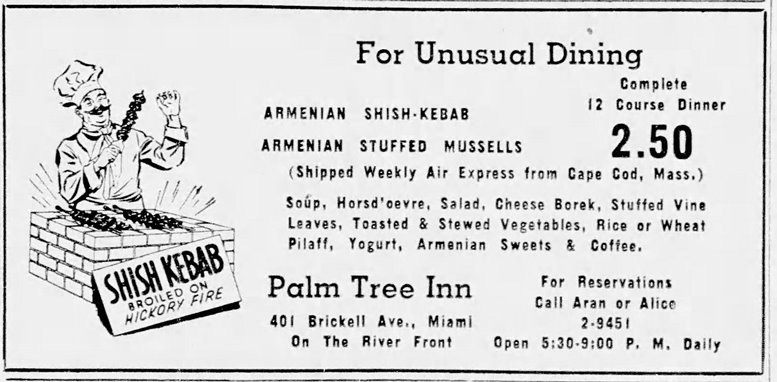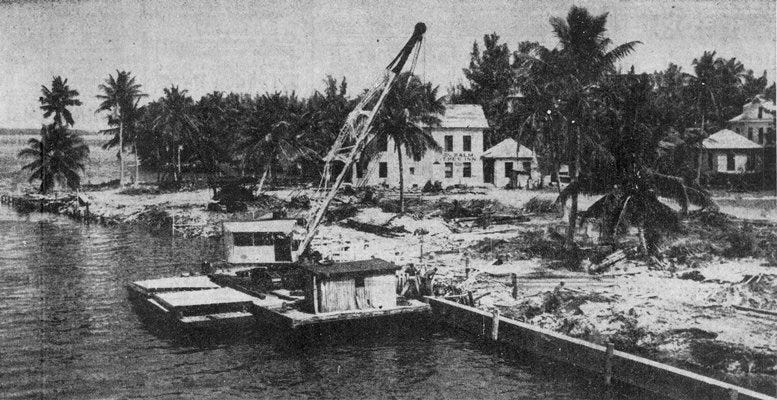Cottages of Brickell Point
Two cottages that sat on Brickell Point for forty years and once were the temporary residences of both James and Charles Deering from the family who founded International Harvester.
The headline in the Miami Metropolis on June 3, 1910, read “An Old Landmark About to Become a Memory” which was referencing the end of the store building on Brickell Point. The structure was constructed by William Brickell and others in 1871 and served as a trading post for the surrounding area up until the beginning of the twentieth century. Through the years, the store, also referred to as the ‘Indian Trading Post’, served as a market, post office, courthouse, and hotel during its thirty-nine-year history.
However, by the start of the second decade of the twentieth century, the building was unused and obsolete, and the family felt that the prime waterfront property would be better served for residential purposes. After removing the store, the Brickells designed and constructed two large, modern residences, one on the former location of the trading post, and the other about a hundred feet south of the first structure. Once construction was completed in 1910, these two cottages, as they were referred to in local newspapers, would reside on Brickell Point for the next forty years.
Cottages Built in 1910
By the onset of the second decade of the twentieth century the city of Miami was growing faster than its ability to provide housing for tourists and seasonal residents. On the north side of the river, some single-family residences were converted into rooming houses to help address the demand for accommodations. By the end of the first decade of the twentieth century, the Brickells seized on the opportunity to help alleviate the housing problem by erecting two cottages near the family homestead on Brickell Point.
In the Metropolis article on June 3, 1910, the writer announced a new residence nearing completion on Brickell Point. The setting of the new structure was described as follows:
“This house is one of the most beautiful in this section and placed as it is in the setting of fine old trees and rare flowers, with its lawn sloping down to the river on one side and to the bay on the other is probably the most attractive winter home in Miami.”
The two residences constructed were composed of white artificial stone, made by the Art Stone Construction Company, and included a twelve-hundred-foot veranda with a high ceiling and situated to capitalize on the cross breeze offered by the open location of Brickell Point. Both homes were constructed near the Brickell family home, allowing them to closely monitor and respond to the requests of their affluent guests.
The first cottage, residing on the former location of the trading post, was given the address of 401 Brickell Avenue. The interior of the home was described by the Metropolis as follows:
“A fifteen-foot hall running from the big entrance doors on the east ends in a handsome stairway. From this hall, four spacious rooms open, all connecting with double doors. On the left are the parlor and library. To the right a living room and a dining room. A butler’s pantry and servant’s dining room complete the apartments in the main building. On the second and third floors there are ten airy bedrooms. An elevator has been installed in the house. There are several fireplaces and many other comfort-adding devices.”
The woodwork in the building was of highly polished, curly pine and the roof was made with metal shingles. The Brickells took care in laying out the grounds providing a winding road and circular driveway to provide easy access to both residences. The two cottages were north of the Brickell family home, which was located on the southern end of Brickell Point.
The second structure modeled the first in design and materials and was given the address of 409 Brickell Avenue. This residence was constructed 100 feet south of 401 Brickell and was completed prior to the start of the 1910-11 winter season which typically began in December.
Maybe it was the lexicon of the day, but local newspaper articles would consistently describe both structures as ‘cottages’ when announcing the arrival of a prominent visitor staying at one of the two residences. Both homes seemed a bit large and extravagant to be labeled as a cottage, but that didn’t stop early twentieth century writers from using the term to describe the two dwellings on Brickell Point.
Schwab Family at 401 Brickell
Gustav Schwab who was the head of Oelrichs & Company in New York City was a wealthy businessman who frequently left the harsh winters of the Big Apple to enjoy the winter season in Miami. Schwab was a frequent guest at the Royal Palm Hotel in prior years but took the opportunity to rent the 401 Brickell cottage when it became available in 1910.
Winter life in Miami was very tranquil for the affluent visitors of Miami in 1910. According to the social pages in the Metropolis, when they weren’t hosting afternoon teas at their Brickell Point cottage, the Schwab family frequently ventured over the Miami River to visit and socialize with friends staying at Henry Flagler’s iconic Royal Palm Hotel.
Despite transitioning to Miami’s southside during the 1910 season, the Schwab family only rented the 401 Brickell Avenue cottage for one season because Gustav and his wife unexpectedly passed away prior to the next winter season. Following the 1910-11 winter season, this residence was rented by three internationally known celebrities from 1912 until 1921.
Cross Family at 409 Brickell
The first people to rent the 409 Brickell Avenue cottage were the Frosts, another prominent family from New York City. However, they did not return for the second winter season which made it available for the Cross family, who also hailed from New York. Richard James Cross was a writer, banker, and business partner of Levi P. Morton, who was Vice President during the Benjamin Harrison presidency. Cross and Harrison were partners at the firm of Morton, Bliss & Company, a financial services firm that merged with J.P. Morgan’s Guaranty Trust Company in 1909.
After retiring from the banking industry, Cross wrote for the New York Evening Post and was the author of a book entitled “Selections from Dante.” Once the Cross family began to winter in Miami, Mrs. Cross became active in local charitable causes. On January 23, 1912, she organized a fundraiser at 409 Brickell Avenue for the purpose of raising capital to construct a hospital for Miami’s black community. Racial segregation of healthcare facilities in Miami during this time left the black community without a hospital for medical care. Despite initiatives to address this void as early as 1912, there wasn’t a hospital available for the black community until the Christian Hospital opened in Overtown in 1918.
The Cross family reliably rented the residence at 409 Brickell Avenue for seven years from 1911 through 1917. However, tragedy struck on March 30, 1917, when Richard died during his stay on Brickell Point. Despite the loss of a loyal guest, the Brickells continued to lease the property as a seasonal rental for the next nearly two decades. This changed in the mid-1930s when the cottage was rebranded as the Brickell Point Inn.
Historic Figures Stay on Brickell Point (1912 – 1921)
In December of 1912 William Jennings Bryan, known as the Great Commoner, was ready to step away from the spotlight and relax. He had run for President of the United States in 1896, 1900 and 1908 on the Democratic ticket. Despite being defeated all three times, twice to Theodore Roosevelt and once to Howard Taft, he actively campaigned to help lead Woodrow Wilson to triumph in November of 1912.
After the election, Bryan traveled to Miami for what he described as a respite from politics so that he could focus his attention on improving the property he purchased from Mary Brickell a year earlier. He bought the lot at 3115 Brickell Avenue to build a residence he named ‘Villa Serena’. While he was visiting Miami to work on clearing his property and overseeing the construction of his estate, he rented the 401 Brickell Avenue cottage for the 1912 winter season. However, he only leased the Brickell Point cottage for one season, choosing to move to 804 Brickell Avenue the following winter to presumably be closer to his property further south.
The Miami Metropolis announced the arrival of the Bryans in an article dated November 24, 1912, as follows:
“Mr. and Mrs. Bryan have set up their lares and penates in the cottage on Brickell Point for the time being, and if permitted to do so will settle down to the prosaic duties of housekeeping, though it may be some time before the rare sight of viewing the Illustrious Commoner marketing with a basket on his arm may be seen.”
The next guest at the 401 cottage was another real estate client of the Brickell family. James Deering purchase 130 acres south of Bryan’s Villa Serena to build Villa Vizcaya. Given the magnitude of the effort to build his residence, James was unable to move into his new estate until December of 1916. From the time he purchased the property from Mary Brickell until he moved into Vizcaya, James was listed as staying at 401 Brickell Avenue.
Four years after James Deering moved into Villa Vizcaya, Charles Deering was registered as leasing the Brickell Point cottages from 1920 – 1922. In 1920, he was listed at the 409 cottage, and the next two years he was listed at the 401 building. These years coincided with the timeframe that Charles was waiting for his residence to be completed at the Deering Estate in South Dade County.
Brickell Point Inn (1934 – 1936)
By 1934 the Brickell family decided to lease 409 Brickell Avenue, the southern cottage, to a group that branded the residence as the Brickell Point Inn. The establishment offered nightly guests a beautiful view of the bay, a short walk to downtown Miami, and good fishing off the docks jetting out from Brickell Point, all at a reasonable rate beginning at $10 per week. The hostelry, which opened in November of 1934 and was managed by Mrs. Mezey of Warwick, New York, also offered home-cooked Hungarian food from the restaurant operating within the cottage.
One of the more renowned guests of the Inn in March of 1935 was Katherine Devereux Blake who was the daughter of Lillie Devereux Blake, a prominent pioneer leader of the woman’s suffrage movement and founder of the Lillie Devereux Blake School in New York. Katherine was the principal of her mother’s school for 34 years and was widely regarded as one of the leading women educators in the country. While her primary purpose for visiting Miami was vacation, she was a guest of the Cushman School to observe assembly exercises during one of her afternoons.
The Brickell Point Inn concept didn’t last long. The final reference to the Inn in local newspaper classified ads was in May of 1936. The next winter season the residence was advertised as a boarding house without any specific branding. It was managed in this manner until Maude Brickell sold the land on which the building stood in the late 1940s.
Palm Tree Inn (1947 – 1950)
In 1947, the 401 Cottage was leased to an Armenian family who branded the converted residence to the Palm Tree Inn. The family advertised the hotel with the tagline of “A Country Atmosphere” providing a porch dining room that served exotic middle eastern food. The restaurant served traditional Armenian dinners and hoped to attract customers with the catch phrase “A Taste That Will Always Linger”.
Given the theme of the hotel and restaurant, it became a gathering spot for visitors and residents of Armenian heritage. However, the Palm Tree Inn had a short run on the point when it closed in preparation for the development of a new water-side apartment complex. Once the northern parcel of the point was sold, it wasn’t long until both cottages were removed to accommodate the Brickell Point Apartments.
Cottages Removed in 1950
On March 11, 1948, the Elks Club agreed to purchase the five-acre Brickell Point for $250,000 from the Brickell Estate. Maude Brickell, who was the last heir to live in the family home at 501 Brickell Avenue, added a stipulation to the deal that she could live in the residence for the remainder of her life, with the lot and structure to revert to the Elks Club after her death.
The Elks Club retained the right to decide what to do with the two cottages on the point after the closing of the sale which took place on October 22, 1948. The club sold the northern portion of the 5-acre plot of land to a developer who constructed the Brickell Point Apartments in 1950.
The additions of the new Elks Club post and the Brickell Point Apartments necessitated the removal of the cottages. Demolition of both residences took place when the construction firm began clearing the grounds to erect the apartment complex in late April of 1950. The Brickell Point Apartments opened in October of the same year.
Following the death of Maude Brickell in November of 1960, the family residence that stood for nearly a century was razed as well. While Brickell Point retains the family name, all the buildings constructed by the family are long gone. The only structure that has endured the test of time is the Brickell Mausoleum, which still stands in Brickell Park, located just south of what was once the family residence at 501 Brickell Avenue.
Resources:
Miami Metropolis: “Will Be Many Here in the Cottage Colony”, February 28, 1910.
Miami Metropolis: “An Old Landmark About to Become but A Memory”, June 3, 1910.
Miami Metropolis: “Philanthropic Ladies to Help the Colored People”, January 23, 1912.
Miami Herald: “William Jennings Bryan Comes to Rest and Recreate – Politics and Everything Else Will be Tabooed”, November 24, 1912.
Miami Herald: “Richard James Cross Obituary”, March 31, 1917.
Miami Herald: “Widely Known Woman Educator is Guest at School Exercises”, March 24, 1935.
Miami News: “Elks Approve Move to Buy Brickell Point”, Marc 11, 1948.
Miami News: “Elks Complete Purchase of Plot”, October 22, 1948.
Miami News: “Ground Cleared for Apartments”, April 27, 1950.
Miami Herald: “Work Starts on Swank Downtown Apartment Group”, May 7, 1950.
Images:
Cover: Cottages on Brickell Point on July 8, 1940. Courtesy of Miami-Dade Public Library, Romer Collection.
Figure 1: Brickell Trading Post in 1900. Courtesy of Florida State Archives.
Figure 2: Postcard of Brickell Point in 1918. Courtesy of Author.
Figure 3: Article in Miami News on January 23, 1912. Courtesy of Miami News.
Figure 4: Brickell Point Cottages. Courtesy of HistoryMiami Museum.
Figure 5: Aerial of Brickell Point in the 1930s. Courtesy of HistoryMiami Museum.
Figure 6: Ad for Palm Tree Inn on January 1, 1949. Courtesy of Miami Herald.
Figure 7: Clearing Grounds of Brickell Point on May 7, 1950. Courtesy of Miami Herald.





